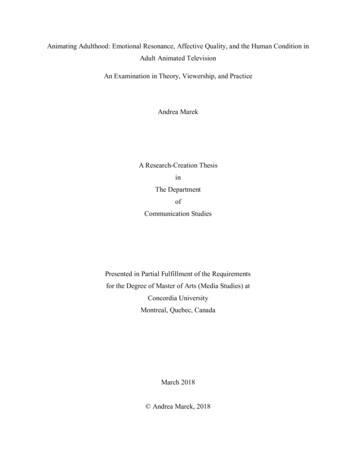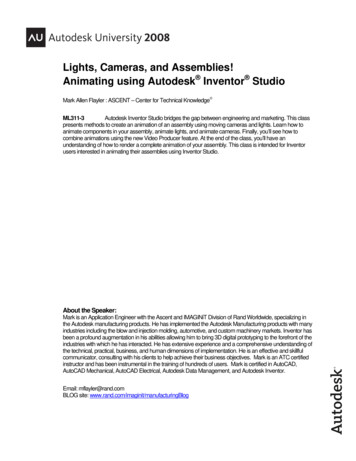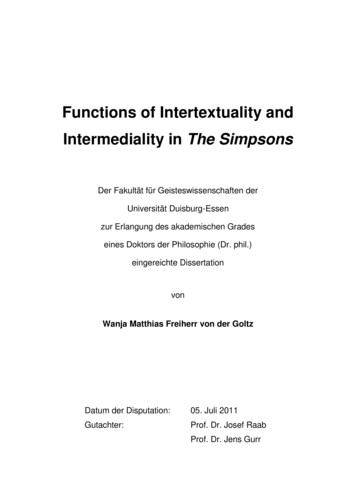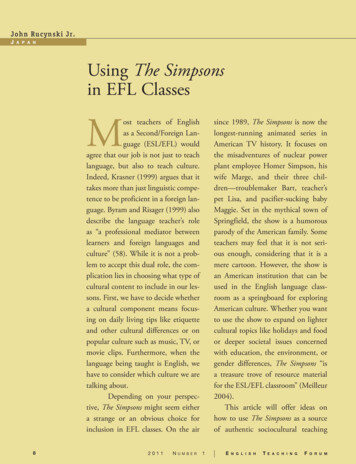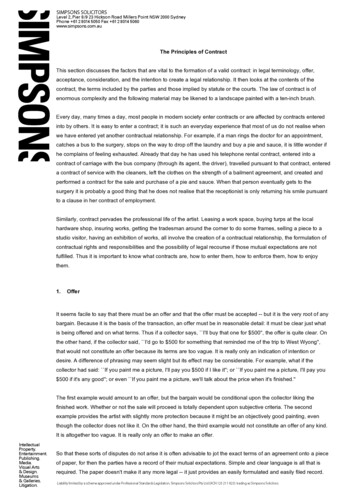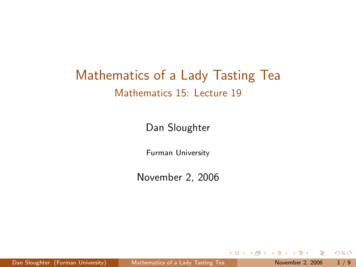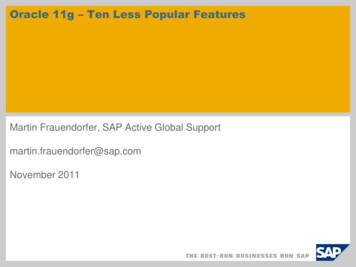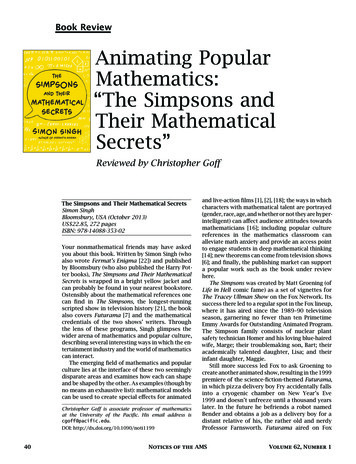
Transcription
Book ReviewAnimating PopularMathematics:“The Simpsons andTheir MathematicalSecrets”Reviewed by Christopher GoffThe Simpsons and Their Mathematical SecretsSimon SinghBloomsbury, USA (October 2013)US 22.85, 272 pagesISBN: 978-14088-353-02Your nonmathematical friends may have askedyou about this book. Written by Simon Singh (whoalso wrote Fermat’s Enigma [22]) and publishedby Bloomsbury (who also published the Harry Potter books), The Simpsons and Their MathematicalSecrets is wrapped in a bright yellow jacket andcan probably be found in your nearest bookstore.Ostensibly about the mathematical references onecan find in The Simpsons, the longest-runningscripted show in television history [21], the bookalso covers Futurama [7] and the mathematicalcredentials of the two shows’ writers. Throughthe lens of these programs, Singh glimpses thewider arena of mathematics and popular culture,describing several interesting ways in which the entertainment industry and the world of mathematicscan interact.The emerging field of mathematics and popularculture lies at the interface of these two seeminglydisparate areas and examines how each can shapeand be shaped by the other. As examples (though byno means an exhaustive list): mathematical modelscan be used to create special effects for animatedChristopher Goff is associate professor of mathematicsat the University of the Pacific. His email address iscgoff@pacific.edu.DOI: http://dx.doi.org/10.1090/noti119940and live-action films [1], [2], [18]; the ways in whichcharacters with mathematical talent are portrayed(gender, race, age, and whether or not they are hyperintelligent) can affect audience attitudes towardsmathematicians [16]; including popular culturereferences in the mathematics classroom canalleviate math anxiety and provide an access pointto engage students in deep mathematical thinking[14]; new theorems can come from television shows[6]; and finally, the publishing market can supporta popular work such as the book under reviewhere.The Simpsons was created by Matt Groening (ofLife in Hell comic fame) as a set of vignettes forThe Tracey Ullman Show on the Fox Network. Itssuccess there led to a regular spot in the Fox lineup,where it has aired since the 1989–90 televisionseason, garnering no fewer than ten PrimetimeEmmy Awards for Outstanding Animated Program.The Simpson family consists of nuclear plantsafety technician Homer and his loving blue-hairedwife, Marge; their troublemaking son, Bart; theiracademically talented daughter, Lisa; and theirinfant daughter, Maggie.Still more success led Fox to ask Groening tocreate another animated show, resulting in the 1999premiere of the science-fiction-themed Futurama,in which pizza delivery boy Fry accidentally fallsinto a cryogenic chamber on New Year’s Eve1999 and doesn’t unfreeze until a thousand yearslater. In the future he befriends a robot namedBender and obtains a job as a delivery boy for adistant relative of his, the rather old and nerdyProfessor Farnsworth. Futurama aired on FoxNotices of the AMSVolume 62, Number 1
for four years, after which reruns were shownon the Cartoon Network for four more years.Underground popularity resurrected the showfor four direct-to-video movies and an eventualreturn to series television on Comedy Central. Theshow won two Emmys for Outstanding AnimatedProgram—one while at Fox and the other at ComedyCentral—before coming to an end in 2013.Both The Simpsons and Futurama are immenselypopular, having been seen by millions of viewers.So, any mathematical references or jokes containedin their episodes are transmitted to many morepeople than a typical instructor of mathematics canever hope to reach. As someone interested in theways in which popular culture and mathematicsinteract, I am thrilled that a large publisher anda well-known author are shedding more light onsome interesting examples of the interplay ofmathematics and popular culture.But the professional mathematical communityis not Singh’s target audience. Indeed, little in thisbook will be new to mathematicians who bothobserve and critique popular culture, especiallythose who are familiar with the work of scholarsin this field. In particular, Dr. Sarah J. Greenwaldand Dr. Andrew Nestler have been publishingspecifically on The Simpsons and Futurama forover ten years and have created and maintainedextensive websites [15], [19], [12]. I too havelong been interested in this area, ever sinceI began giving conference presentations aboutmathematics and the movies in 2004. Shortlythereafter, Greenwald and I coedited a specialissue of the journal PRIMUS [9] that focused onmathematics and popular culture. We have hadanother collaboration since then [4].Singh interviewed Greenwald and Nestler forhis book, and he quotes them throughout Chapter 8. He also includes an interesting anecdoteabout how the two mathematicians were implicitlyresponsible for adding mathematical content toan episode of The Simpsons. After Greenwald wasinterviewed for NPR’s Science Friday in 2005, someof the writers heard the program. Intrigued thatmathematicians were using material from the showin their classrooms, they invited Greenwald andNestler to Fox Studios for a table-read, a key step inthe process of writing any television script. Afterthe mathematicians had left, however, the writersrealized that the baseball-themed episode, titled“Marge and Homer Turn a Couple Play” (2006),contained no jokes of a mathematical nature. Sothey added three possible attendance numbers at abaseball game as a freeze-frame gag, that is, a jokethat goes by so quickly that in order to see it fully,viewers have to record the show and pause theplayback. Unbeknownst to most of the audience,the three numbers were a Mersenne prime (8191),January 2015a perfect number (8128), and a narcissistic number(8208).Likely constrained by the fact that he was writinga popular book, Singh does not describe Greenwaldand Nestler’s (or others’) prior contributions tothe field in much detail, though he does mentionthem again in the acknowledgments and includeslinks to their definitive websites. For the academicaudience of these Notices, however, I will continueto cite references in the area of mathematics andpopular culture when they arise during the courseof this review.As do many mathematics books, The Simpsonsand Their Mathematical Secrets begins with a Chapter Zero, in which Singh outlines some of the manyways that academia has interacted with the show.Professors of philosophy, psychology, and religionhave written about how ideas in their disciplinesarise in various plots and subplots revolving aroundthe Simpson family. Even President George H. W.Bush famously criticized the Simpsons as antithetical to the wholesome all-American Waltons. Thewriters responded satirically (via Bart), “Hey, we’rejust like the Waltons. We’re praying for an end tothe Depression, too” [p. 2].Singh rightly shines his spotlight on some of thewriters themselves and their personal mathematical accomplishments. Since I also refer to thesewriters, I will list them by name: J. Stewart Burns (BS,mathematics, Harvard; MS, mathematics, Berkeley);David S. Cohen (BS, physics, Harvard; MS, computer science, Berkeley); Al Jean (BS, mathematics,Harvard); Ken Keeler (BS and PhD, applied mathematics, Harvard); and Jeff Westbrook (BS, physics,Harvard, and PhD, computer science, Princeton).Singh includes quotations in which some writerspoint out the similarities between mathematicsand humor: Burns says that a mathematical puzzleand a joke share a common structure, and Cohenlikens the task of telling a complex story in a shortamount of time to solving a big logic puzzle. Formore information about the writers, see [12], andfor possible classroom uses of their interviews, see[11].In Chapter 3, titled “Homer’s Last Theorem,”Singh mentions some connections between thesewriters and the story of Andrew Wiles’s proofof Fermat’s Last Theorem, the topic of Singh’s1997 book, Fermat’s Enigma [22]. In particular,when Wiles spent a brief time at Harvard, Jeanattended some of his lectures, and when Cohenwas a graduate student at Berkeley, he attendedsome lectures of Ken Ribet. Singh mentions theseconnections while discussing a near-miss solutionto Fermat’s equation that appears as a backgroundfreeze-frame gag on Homer Simpson’s chalkboardin the episode “The Wizard of Evergreen Terrace”(1998), namely, 398712 436512 447212 . CohenNotices of the AMS41
360b/Shutterstock.comintentionally inserted this bit of mathematics as aprank, knowing that most calculators would, at firstglance, not reveal its falsity, and he was thrilled toread the buzz that it generated online. As Cohensays in the book, “ when we get the opportunity toraise the level of discussion—particularly to glorifymathematics—it cancels out those days when I’vebeen writing those bodily function jokes” [p. 37].Interestingly, a couple of years after this near-missexample aired, Noam Elkies acknowledged it in apaper giving a new computational algorithm toobtain more general results [5].Some might find it surprising that there arerelatively close connections between the mathematics community and the entertainment industry.In Chapter 5, Singh introduces his audience to theErdős number, which indicates how far removedsomeone is from Paul Erdős on the coauthor graph.Writer Westbrook has an Erdős number of 3, asdoes Cohen. A similar metric is playfully employedby fans of the movie business. An actor’s “Baconnumber” is her or his distance from Kevin Bacon onthe costar graph, and Westbrook happens to havea Bacon number of 3. In the same way that one’sErdős number can be used as a proxy for one’sconnectedness to the mathematical community,so does one’s Bacon number suggest prominencein Hollywood circles. Thus the tongue-in-cheek“Erdős-Bacon number” (i.e., the sum of the twonumbers) can be used as a rough measure ofsomeone’s links to both Hollywood and the worldof mathematics. As we have already seen, Westbrook’s Erdős-Bacon number is 6. Surprising to mewere the relatively low Erdős-Bacon numbers ofthe Hollywood stars Singh mentions in the book.Academy Award-winner Colin Firth’s Erdős-Baconnumber is 7, while Academy Award-winner NataliePortman’s is 6. Though not listed by Singh, Danica42McKellar (from The Wonder Years and The WestWing) also has an Erdős-Bacon number of 6. Singhpoints out that Erdős himself has an Erdős-Baconnumber of 4, but that this is not minimal. Apparently the lowest, 3, belongs to Bruce Reznick at theUniversity of Illinois.One more aspect about the writers that interested me was that they continued to studymathematics even while writing for television. InChapter 9, Singh tells the story of how severalwriters formed a “math club” and took turnsspeaking to interested audiences or inviting othersto speak, such as Ron Graham, and Greenwaldand Nestler [13]. On an occasion when Cohenaddressed the math club, he explained pancakenumbers, the subject of a paper he wrote as anundergraduate [3]. I was amused by the storyCohen recounts in the book, that after a longjournal lag time during which he began writing atFox, his paper finally appeared in Discrete AppliedMathematics. He excitedly shared his good fortunewith his colleague Keeler, who responded, “Oh yeah,I had a paper in that journal a couple of monthsago.” Keeler’s paper [17] was even coauthored byWestbrook, another writer.Interspersed between the stories of the writersand their mathematical credentials, Singh listsseveral instances of mathematics in The Simpsonsand Futurama and explains them for a generalaudience. Many of these examples involve basicmathematics or statistics, and so I will focus ononly a few that I believe are the most important inthat they show interesting ways that mathematicsand popular culture have the potential to interact.All of these are discussed in the book, startingwith the 1990 joke that sparked Greenwald andNestler’s initial work and ending with the 2014publication of the so-called “Futurama Theorem.”Notices of the AMSVolume 62, Number 1
In Chapter 1, Singh describes the first officialepisode of The Simpsons to air, “Bart the Genius”(1990). In it, Bart writes his name on the completedaptitude test belonging to the class nerd, MartinPrince. Bart is thus “recognized” as gifted andplaced into a different school, where the teacherr3writes y on the board and says, “ if you3determine the rate of change correctly, I thinkyou will be pleasantly surprised.” All the studentsexcept Bart solve the problem and begin to chuckle.The teacher works out the problem on the boardand writes the answer dy r 2 dr as “r dr r ,”saying, “har-de-har-har”.Unlike other examples, Singh avoids explainingthe mathematics behind this one, other than afootnote reminding some readers how to differentiate r n with respect to r . In a 2004 article [14],Greenwald and Nestler explain how they usedthis very scene as part of an assignment in afirst-semester calculus course. They describe howit can help students review material before anexam and how it can even alleviate math anxietyin the classroom.Greenwald and Nestler continue in the samepaper to discuss the non-canon segment “Homer3 ”(1995), in which Homer enters a futuristic threedimensional world (as opposed to the presumablylower-dimensional nature of the Simpson universe)to escape an evening with his sisters-in-law. Classroom use of this vignette, an homage to a classicepisode of The Twilight Zone, can spark a varietyof interesting debates around two- and threedimensional geometry and can initiate studentthinking about the shape of four-dimensional space[14]. Singh devotes his Chapter 13 to “Homer3 ,”where he explains several of the freeze-frame jokesthat the writers have inserted into the background,from statements like “P NP” to Euler’s equation,“eπ i 1.”In addition to providing explanations of variousmathematical tidbits, Singh also describes otherways that popular culture has the potentia
“The Simpsons and Their Mathematical Secrets” Reviewed by Christopher Goff The Simpsons and Their Mathematical Secrets Simon Singh Bloomsbury, USA (October 2013) US 22.85, 272 pages ISBN: 978-14088-353-02 Your nonmathematical friends may have asked you about this book. Written by Simon Singh (who also wrote Fermat’s Enigma [22]) and published by Bloomsbury (who also published the
